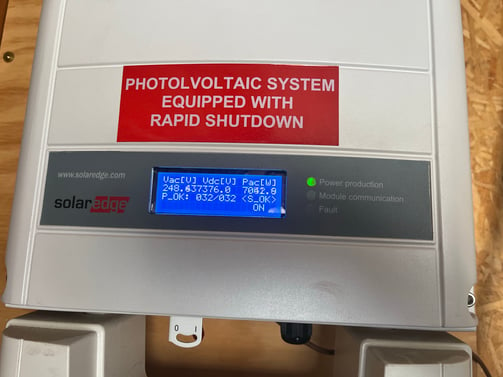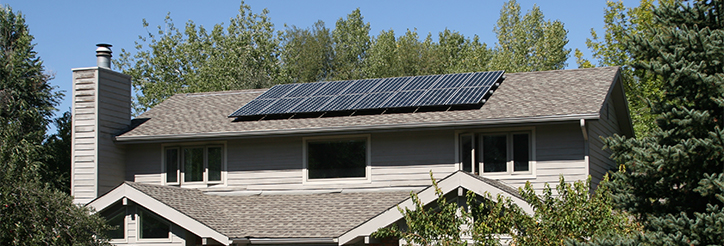Publish Date: April 1st, 2024
Your home solar system is low maintenance and should last beyond the 25-year panel warranty. In fact, in most cases consistent solar monitoring is all that’s needed on your end to ensure the health of your system.
While home solar system monitoring is simple, it helps you avoid major headaches, like losing power or missing production. And Namaste Solar is here to be your partner along the way.
So, what is home solar system monitoring? It simply refers to watching your online portal to notice any changes in production or notifications that something isn’t working properly.
And monitoring a Namaste Solar built system is as simple as monitoring your system in the monitoring portal. It’s fun to do and it will help you manage the health of your system while empowering you to take action.
We like to think of solar system maintenance like the maintenance you do on your car. Your vehicle has several indicators of its health. Some you find on the dashboard while other indicators can be stickers on your windshield or in your user manual. And by consistently monitoring those indicators, you know when you need to get fuel or change your oil.
Of course, being proactive is best. And by regularly tuning into health indicators, you’re empowered to be the biggest advocate for your vehicle’s health. Your care is what ensures a lifetime of smooth drives.
In the same way, consistent solar system monitoring of its health indicators are what ensure a lifetime of smooth power production.
So, what does monitoring entail? How can you ensure that you’re doing your part? And how can you know if your system is working properly?
We got you. Read on to learn those answers.
What Happens After Installation?
If your solar system was built by a company other than Namaste Solar, you’ll need to reach out to them to learn the specifics of caring for your system after installation. However, it’s likely that their processes are similar to ours.
At Namaste Solar, we aim to make it as simple as possible after installation.
Once the crews have completed their work and your utility company approves the system, they’ll give you permission to operate (PTO). Then, you’re ready to turn it on. You’ll get an email explaining how to do this but if you need support, our Project Managers can walk you through it, too.
Brin Kelley, one of our Project Managers with the Residential Department, talked about his time helping customers turn their systems on when we caught up with him last week. He shared that, “it’s definitely a high point of the job. All the things have been done, and it’s been months in the making, so that’s pretty fun.”
He shared that during the installation, crews will take the serial number stickers off of the microinverters and create a map of the array on your roof. They’ll scan those serial numbers into Enlighten, the Enphase monitoring portal we currently use, and that creates the array that you see in the portal.
This is what allows for real-time tracking of every piece of the system. It’s how you see live power production from each panel. And it’s how we’re able to troubleshoot any issues in the future.
Once the system is turned on, most customers are really excited about monitoring it. It’s a natural time to be proactive. There’s a new clean energy power plant on your roof, and it’s totally normal to be a little obsessive with checking the system in the beginning.
We encourage you to continue with consistent system monitoring, even after that initial excitement wears off. Because it can be easy to forget, a couple monthly calendar reminders to check your monitoring app can be helpful.
We currently don’t offer long-term proactive monitoring for our systems; we have installed so many systems since we first started in 2005 that we haven’t offered this service as of yet. But we do have a two month check-in with every customer after their system is installed and turned on.
After two months of a new system running, we conduct a complimentary review of your monitoring portal. If we see any issues, a field tech will reach out to you by phone or email to troubleshoot it. And if a site visit is needed, we’ll come out to check on the system and chat with you.
After that check in, monitoring is something we encourage our customers to take into their own hands. But where can you find the health indicators to know if your system is working properly? Let’s take a look.
4 Ways To Know If Your System Is Functioning Normally
You know where to look to see if your car is functioning normally, and we want to give you that same kind of confidence when it comes to your solar system.
To check if your system is working properly, you can use the following indicators:
- Your monitoring portal – Whether you have an Enphase, SolarEdge, EnerVu or another similar portal, that’s where you can see all the vital signs of your system. You’re also seeing power production in real-time, which is crucial to getting a clear idea of system health.

An inside look at the Enphase monitoring portal. The darker the panel, the less production. If seen unexpectedly and consistently, there might be an issue to address
2. Your system inverter – Your vital signs will vary depending on which inverter your system has. But most inverters have a light that indicates it’s connected to the internet and one that indicates it’s on and producing power. You can check with your installation crew or project manager to find out which inverter came with your system.

A SolarEdge inverter with the "power production" light illuminated
3. Your power bill – If you see a power bill that’s larger than normal, that could indicate that you’re using more power from your utility company than you should be. And it’s then possible that your system isn’t producing normally.
4. Namaste Solar service & FAQs – We’ve answered all the common service questions in our solar service FAQ. It’s always a good idea to check out the FAQ page if you’re experiencing issues since there’s a good chance we covered it there. If you don't find your answer there, fill out the service request form below the FAQ's and our team will help you out. Submitting a service request immediately creates a ticket and puts it in our queue, so it is the fastest way to get in contact with our team.
Caring for your solar system is pretty simple. “Once it’s in the customer’s hands, everything is built to last. So, the panels are just gonna sit there and work,” said Brin. But he does encourage customers to be active participants in the process. And following the advice of setting a couple monthly calendar reminders is a good way to ensure you’re checking things enough. You can easily do this on your phone or in your calendar. Doing so takes the pressure off you to remember, while ensuring that you’re checking it consistently enough.
We Want You To Feel Empowered to Take Part In Solar System Monitoring
Our hope is that monitoring your system is something you feel good about doing, rather than it feeling like a chore. Seeing real-time power generation numbers from your system is an exciting thing. You can even show off how much power your solar system is producing to friends and family with the app. And you can use that as an opportunity to check on its health.
We’ll always be here to support you. In fact, prioritizing people is something we take pride in as an employee-owned, Certified B Corp. Use the four steps above to check that your system is operating well, but if not, utilize the FAQ and service form to get your system running smoothly again.
If you’re considering getting a solar system for your own roof, we’d love to chat. With a clearer idea of how simple maintenance and monitoring can be, you’re in a great place to learn more about your options from our non-commissioned sales reps. We’ll be the first to tell you if solar isn’t right for you since we take an educational approach. To have a no-pressure chat and get a free quote, click the button below.


